Tuesday, April 18, 2006
21. 'Lost' on TV "4 8 15 16 23 42"
Spoiler Warning!
Note: "4 8 15 16 23 42" contains "8 15", as in 'Oceanic Flight 815'.
So far, 51 of the 72 crash survivors have been identified, at least in part:
1. Aaron Littleton - Claire's newborn baby
2. Ann Lucia Cortez - tailie
3. Barbara Joanna Miller - 8th lost
4. Bernard - tailie
5. "Blonde guy" - tailie - taken by the Others 1
6. Boone Carlyle - 14 - 11th lost
7. Charlie Pace - 14
8. Cindy - tailie - only flight crew survivor - taken by the Others?
9. Claire Littleton - 14
10. Craig - tailie - SOS recruit
11. "Curley-haired guy" - tailie - taken by the Others 2
12. Donald - tailie - 7th lost
13. Edward Mars - US Marshal - 3rd lost
14. Eli - tailie - taken by the Others
15. Emma - tailie - Zack's sister - taken by the Others 3
16. "German guy" - tailie - taken by the Others 4
17. Hugo "Hurley" Reyes - 14
18. Jack Shephard - 14
19. Jim - tailie - taken by the Others 5
20. Jin-Soo Kwon - 14
21. John Locke - 14
22. Kate Austen - 14
23. Lance - skinny guy said Hurley
24. Leslie Artz - 12th lost
25. Libby - tallie
26. Michael Dawson - 14
27. 'Mr. Eko' - tailie
28. Nancy - tailie - taken by the Others 6
29. Nathan - 9th lost
30. Neil - tailie - SOS recruit
31. Pilot - 2nd lost
32. Richard - tailie - SOS recruit
33. Rose - knows her hubby is alive
34. Sawyer (James Ford) - 14
35. Sayid Jarrah - 14
36. Scott Jackson - 10th lost
37. Shannon Rutherford - 14 - 13th lost
38. Steve Jenkins - tailie - SOS recruit
39. Sullivan - treated by Jack for heat rash
40. Sun Kwon - 14
41. Tailie 1 - 4th lost
42. Tailie 2 - 5th lost
43. Tailie 3 - 6th lost
44. Tailie 4 - taken by the Others 7
45. Tailie 5 - taken by the Others 8
46. Tailie 6 - taken by the Others 9
47. Tailie 7 - taken by the Others 10
48. Tracy - message in a bottle
49. "Turbine Man" - 1st lost
50. Walter Lloyd Porter - 14 - taken by the Others
51. Zack - tailie - Emma's brother - taken by the Others 11
52.
53.
54
55.
56.
57.
58.
59.
60.
61.
62.
63.
64.
65.
66.
67.
68.
69.
70.
71.
72.
The major characters:
Season 1:
1. Shannon Rutherford * died Ep ???
2. Boone Carlyle * died Ep 118
3. Hugo "Hurley" Reyes
4. Claire Littleton
5. Charlie Pace
6. Walt Lloyd
7. Michael Dawson
8. Sayid Jarrah
9. Jin-Soo Kwon
10. Sun Kwon
11. John Locke
12. Sawyer
13. Kate Ryan
14. Jack Shephard
Season 2:
1. Ana Lucia Cortez
2. Libby
Season 1:
1.1. Pilot Episode, Part I - 22 Sep 2004, Wed.:
[Background on Jack?]
1. "Turbine Man" sucked into still-running engine. 49 survivors are left.
2. Aircraft pilot of Flight #815 by the "monster". 48 survivors are left.
1.2. Pilot Episode, Part II - 22 Sep 2004, Wed.:
[Background on ?]
1.3. Episode 101: "Tubula Rasa" - 06 Oct 2004, Wed.:
[Background on Kate]
3. The wounded US Marshal Edward Mars mercy killed by Jack. 47 survivors are left.
1.4. Episode 102: "Walkabout" - 13 Oct 2004, Wed.:
[Background on Locke?]
1.5. Episode 103: "White Rabbit" - 20 Oct 2004, Wed.:
[Background on Jack]
4. Barbara Joanna Miller swept out to sea while swimming. 46 survivors are left.
1.6. Episode 104: "House of the Rising Sun" - 27 Oct 2004, Wed.:
[Background on Jin and Sun]
1.7. Episode 105: "The Moth" - 03 Nov 2004, Wed.:
[Background on Charlie]
1.8. Episode 106: "Confidence Man" - 10 Nov 2004, Wed.:
[Background on Sawyer]
1.9. Episode 107: "Solitary" -17 Nov 2004, Wed.:
[Background on Sayid]
1.10. Episode 108: "Raised by Another": 01 Dec 2004, Wed.:
[Background on Claire]
1.11. Episode 109: "All the Best Cowboy's Have Daddy Issues" - 08 Dec 2004, Wed.:
[Background on Jack II]
1.12. Episode 110: "Whatever the Case May Be" - 05 Jan 2005, Wed.:
[Background on Kate]
1.13. Episode 111: "Hearts and Minds" - 12 Jan 2005, Wed.:
[Background on Shannon and Boone]
1.14. Episode 112: "Special" - 19 Jan 2005, Wed.:
[Background on Michael and Walt]
1.15. Episode 113: "Homecoming" - 09 Feb 2005, Wed.:
[Background on Charlie]
5. Scott Jackson murdered by Ethan Rom. 45 survivors are left.
x. Ethan Rom murdered by Charlie Pace. Not on the plane.
1.16. Episode 114: "Outlaws" - 16 Feb 2005, Wed.:
[Background on Sawyer]
1.17. Episode 115: "...In Translation" - 23 Feb 2005, Wed.:
[Background on Jin]
1.18. Episode 116: "Numbers" - 02 Mar 2005, Wed.:
[Background on Hurley]
1.19. Episode 117: "Deus ex Machina" - 30 Mar 2005, Wed.:
[Background on Locke]
1.20. Episode 118: "Do No Harm" - 06 Apr 2005, Wed.:
[Background on Locke]
6. Boone Carlye died of crushing injuries. 44 survivors are left.
1.21. Episode 119: "The Greater Good" - 04 May 2005, Wed.:
[Background on Sayid]
1.22. Episode 120: "Born to Run" - 11 May 2005, Wed.:
[Background on Kate]
1.23. Episode 121: "Exodus Part One" - 18 May 2005, Wed.:
[Background on ?]
1.24. Episode 122: "Exodus Part Two" - 25 May 2005, Wed.:
[Background on ?]
7. Dr. Leslie Artz died when dynamite he was holding exploded. 43 survivors are left.
Season 2:
2.1. "Man of Science, Man of Faith" - 21 Sep 2005, Wed.:
2.2. "Adrift" - 28 Sep 2005, Wed.:
2.3. "Orientation" - 05 Oct 2005, Wed.:
2.4. "Everybody Hates Hugo" - 12 Oct 2005, Wed.:
2.5. "... And Found" - 19 Oct 2005, Wed.:
2.6. "Collision" - 09 Nov 2005, Wed.:
2.7. "The Other 48 Days" - 16 Nov 2005, Wed.:
2.8. "Collision" - 23 Nov 2005, Wed.:
2.9. "What Kate Did" - 30 Nov 2005, Wed.:
2.10. "The 23rd Palm" - 11 Jan 2006, Wed.:
2.11. "The Hunting Party" - 18 Jan 2006, Wed.:
2.12. "Fire + Water" - 25 Jan 2006, Wed.:
2.13. "The Long Con" - 08 Feb 2006, Wed.:
2.14. "One of Them" - 15 Feb 2006, Wed.:
2.15. "
Saturday, April 15, 2006
20. Colditz Castle: Who Escaped!
I have taken the liberty of subdividing each list up into groups, based on where they escaped from, as this was sometimes a reason for their inclusion or omission. All seven list makers, and their often varied results, follow.
1. Georg Martin Schädlich listed 16. He was a WWII Colditz unteroffizier guard and diarist. In 1992 his grandson, Thomas Schädlich, published Colditzer Schloßgeschichten: Die Geschichte des Oflag IV C in Colditz nach dem Tagebuch des Georg Martin Schädlich. The list appeared on page 83 of the German language edition, and on page 82 of the English language edition.
A. Escaped from behind the stone walls of Colditz castle itself [8]:
1. Neave
2. Luteijn
3. Fowler
4. van Doorninck
5. Reid
6. Wardle
7. Stephens
8. Littledale
B. Escaped from within the grounds of Colditz castle [4]:
9. Mairesse-Lebrun
10. Larive
11. Steinmetz
12. Giebel
C. Escaped from the town of Colditz [3]:
13. Durand-Hornus
14. de Frondeville
15. Prot
D. Escaped from hospital, prison, or cell, but while still on the Colditz roster [1]:
16. Paddon
2. Winston G. Ramsey listed 18. He was editor of After the Battle: Colditz (magazine issue number 63), which was published in 1989 by "Battle of Britain Prints International". The list appeared on page 18.
A. Escaped from behind the stone walls of Colditz castle itself [8]:
1. Neave
2. Luteijn
3. Fowler
4. van Doorninck
5. Reid
6. Wardle
7. Stephens
8. Littledale
B. Escaped from within the grounds of Colditz castle [7]:
9. Le Ray
10. Collin
11. Mairesse-Lebrun
12. Larive
13. Steinmetz
14. Giebel
15. Drijber
C. Escaped from within the town of Colditz [3]:
16. Durand-Hornus
17. de Frondeville
18. Prot
3. Reinhold Eggers described 20 (out of 31 total). He was the WWII Colditz Colditz Duty and Security Officer, and postwar author, who published Colditz: The German Story in 1961. Eggers stated on page 63 that 15 "made the home run", that 15 "got safely to freedom" on page 109 in 1942, and on pages 136-137 that Millar disappeared in 1944. Page numbers here are from the English language "London: Robert Hale, 1991" paperback edition.
A. Escaped from behind the stone walls of Colditz castle itself [9]:
1. Neave
2. Luteijn
3. Fowler
4. van Doorninck
5. Reid
6. Wardle
7. Stephens
8. Littledale
9. Millar
B. Escaped from within the grounds of Colditz castle [7]:
10. Le Ray
11. Collin
12. Mairesse-Lebrun
13. Larive
14. Steinmetz
15. Giebel
16. Drijber
C. Escaped from the town of Colditz [3]:
17. Durand-Hornus
18. de Frondeville
19. Prot
D. Escaped from a hospital, prison, or cell, but while still on the Colditz roster [1]:
20. Paddon
4. P.R. [Patrick Robert] Reid listed 31. He was a WWII POW at Colditz until his successful escape in October 1942. Postwar, he wrote The Colditz Story (1952), Men of Colditz (1953), and then combined his first two books into Escape from Colditz (date unknown). Later he wrote Colditz: The Full Story (1984), which is my principle source. For page numbers see #7 below.
A. Escaped from behind the stone walls of Colditz castle itself [10]:
1. Neave
2. Luteijn
3. Fowler
4. van Doorninck
5. Reid
6. Wardle
7. Stephens
8. Littledale
9. Millar
10. Elliott
B. Escaped from within the grounds of Colditz castle [7]:
11. Le Ray
12. Collin
13. Mairesse-Lebrun
14. Larive
15. Steinmetz
16. Giebel
17. Drijber
C. Escaped from the town of Colditz [4]:
18. Tatischeff
19. Durand-Hornus
20. de Fronteville
21. Prot
D. Escaped from a hospital, prison, or cell, but while still on the Colditz roster [8]:
22. Kroner
23. Boucheron
24. Odry
25. Navelet
26. Remy
27. Paddon
28. Rouillez
29. Darthenay
E. Escaped as Colditz 'alumni' after transfer to another POW camp [2]:
30. Hammond
31. Lister
5. Unknown author(s) listed 31. This list is from the 'Colditz' article in wikipedia.com as it appears now in April 2006.
A. Escaped from behind the stone walls of Colditz castle itself [9]:
1. Neave
2. Luteijn
3. Fowler
4. van Doorninck
5. Reid
6. Wardle
7. Stephens
8. Littledale
9. Millar
B. Escaped from within the grounds of Colditz castle [7]:
10. Le Ray
12. Collin
13. Mairesse-Lebrun
14. Steinmetz
15. Larive
16. Giebel
17. Drijber
C. Escaped from the town of Colditz [3]:
18. Durand-Hornus
19. de Frondeville
20. Prot
D. Escaped from a hospital, prison, or cell, but while still on the Colditz roster [7]:
21. Boucheron
22. Odry
23. Navelet
24. Remy
25. Paddon
26. Bouillez
27. Darthenay
E. Escaped as Colditz 'alunmi' after transfer to another POW camp [4]:
28. van Lijnden
29. Hammond
30. Lister
31. Mazumdar
6. Henry Chancellor counted 32, but listed 37. Based mostly on interviews, Chancellor's book, Colditz: The Untold Story of World War II's Great Escapes was published in 2001. His "List of Escape Attempts" appeared on pages 393-404 of his "New York: William Morrow, 2001" edition. I have put an asterick [*] next to the names of the five Chancellor listed as escaping, but he didn't count as a "Home Run".
A. Escaped from behind the stone walls of Colditz castle itself [13]:
1. Neave
2. Luteyn
3. Fowler
4. van Doorninck
5. Reid
6. Wardle
7. Stephens
8. Littledale
9. Millar *
10. Elliott
11. Flinn [Flynn]
12. Barnett
13. Wynn
B. Escaped from within the grounds of Colditz castle [7]:
14. Le Ray
15. Collin
16. Mairesse-Lebrun
17. Larive
18. Steinmetz
19. Giebel
20. Drijber
C. Escaped from the town of Colditz [4]:
21. Tatistcheff
22. Durand-Hornus
23. de Frondeville
24. Prot
D. Escaped from a hospital, prison, or cell, but while still on the Colditz roster [8]:
25. Kroner
26. Boucheron
27. Odry
28. Navelet
29. Remy
30. Paddon
31. Bouillez
32. Darthenay
E. Escaped as Colditz 'alumni' after transfer to another POW camp [5]:
33. Hammond *
34. Lister *
35. Mazumdar *
36. Ferguson *
37. van Lynden
7. I listed 46. I drew up a list of everyone who successfully escaped based especially on Reid's Colditz: The Full Story [C], but also on Reid's Escape from Colditz [E] for three more successful escapers not credited in Reid's Colditz: The Full Story, and three more yet in Chancellor's Colditz: The Untold Story of World War II's Great Escapes [Ch].
Page numbers here for Colditz: The Full Story are from the "New York: St. Martin's Press, 1984" edition. Page numbers here for Escape from Colditz are from the "Philadelphia and New York: J.B. Lippincott, [No date]" edition. Page numbers here for Chancellor's Colditz are from "New York: William Morrow, 2001" edition.
A. Escaped from behind the stone walls of Colditz castle itself [13]:
1. Neave [C, 111-115, 327]
2. Luteijn [C, 111-115, 331]
3. Fowler [C, 162-165, 327]
4. van Doorninck [C, 162-165, 331]
5. Reid [C, 171-175, 327]
6. Wardle [C, 171-175, 327]
7. Stephens [C, 171-175, 327]
8. Littledale [C, 171-175, 327]
9. Millar [C, 219-220, 327]
10. Barnett [E, 277]
11. Elliott [C, 231-235, 327]
12. Flinn [Flynn] [Ch, 403]
13. Wynn [Ch, 403]
B. Escaped from within the grounds of Colditz castle [7]:
14. Le Ray [C, 46-49, 331]
15. Collin [C, 57, 331]
16. Mairesse-Lebrun [C, 63-64, 332]
17. Larive [C, 77-80, 331]
18. Steinmetz [C, 77-80, 331]
19. Giebel [C, 89-92, 331]
20. Drijber [C, 89-92, 331]
C. Escaped from the town of Colditz [4]:
21. Tatischeff [C, 68, 332]
22. Durand-Hornus [C, 105-106, 332]
23. de Frondeville [C, 105-106, 332]
24. Prot [C, 105-106, 332]
D. Escaped from a hospital, prison, or cell, but while still on the Colditz roster [8]:
25. Kroner [C, 83, 330]
26. Boucheron [C, 332]
27. Odry [C, 100, 332]
28. Navelet [C, 100, 332]
29. Remy [C, 144-146, 332]
30. Paddon [C, 147-148, 327]
31. Bouillez [C, 144, 332]
32. Darthenay [C, 203, 332]
E. Escaped as Colditz 'alumni' after transfer to another POW camp [14]:
33. Hammond [C, 175-176, 327]
34. Lister [C, 175-176, 327]
35. Perrin [C, 252-253]
36. Pszczolkowski [C, 213]
37. Ziminski [C, 213-214]
38. Douw van der Krap [C, 222]
39. Kruimink [C, 222]
40. Besson-Guyard [C, 50]
41. Warisse [C, 50]
42. van Lijnden [E, 450]
43. Fraser [E, 452]
44. Mazumdar [C, 184]
45. Romilly [C, 279-285]
46. Ferguson [Ch, 401]
This article is still "Under Construction", and there will be more to come.
Monday, April 10, 2006
19. Colditz Castle: Tour 2, Exterior, North Side & West Side
We'll circle the rest of the way around the exterior of Colditz castle in a counterclockwise direction in Part Two here until we end up back at the entry house again.
Colditz castle north side:
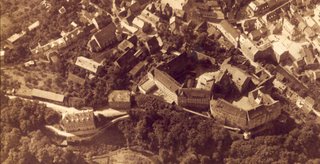
F. Since there isn't an aerial view of Colditz castle from the north, we'll reuse this view from the north-east.
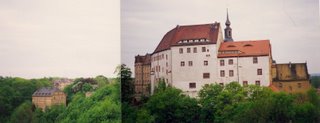
G. And offer this view of the north face facade (from a hill to the north and north-east) that is about the same height as the promontory rock that Colditz was built on.
62. Looking roughly east-south-east from the service road along the north side of Colditz castle. That is the north-east tower on the left, and above on the right was where the WWII long, narrow storage shed sat till it was torn down sometime after the war.
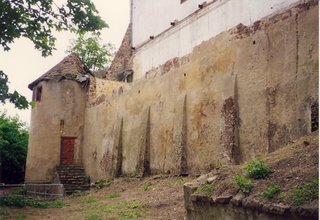
63. A wider view from an almost identical photo looking east-south-east better shows where the WWII long, narrow storage shed roof-line once connected to the north face facade of the castle.

64. This time looking west-south-west at the north-west corner tower. Comparing this photo above with the one above this one it is clearer (than mud) where the two photos overlap. Again, one can see where the WWII long, narrow storage shed attached to the north face facade of the castle.
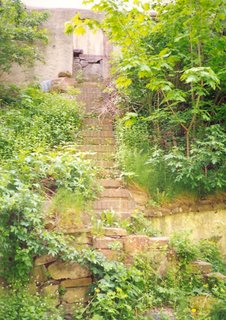
65. The very steep steps up the north retaining wall to where the WWII long, narrow storage shed once stood. We are looking almost due south.
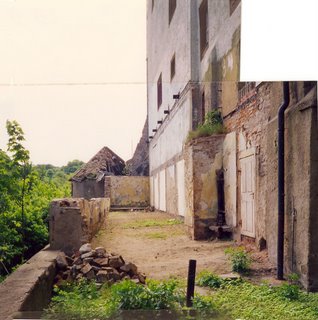
66. and 67. Two almost identical photos, that look almost due east, at the top of those steep steps here show the former shed floor from the top of the steep stairs where the WWII long, narrow storage shed once stood.
These above are all the photos of the short north face facade of the castle. The north-west tower will be included with the tour of the west face of Colditz castle, which begins now.
Colditz castle west side:
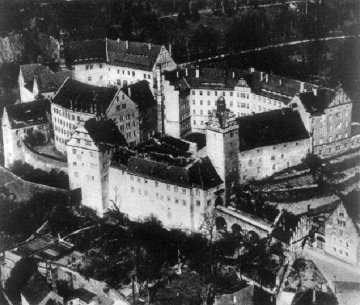 H. This view from the south-west is of the west side of Colditz castle is far more help for the south end of the west side of the castle than it is for the north end where we are starting with the north-west corner tower. The WWII guardhouse is the building unit furthest to the left. The north-west tower's cone-shaped tip top is just barely identifiable just above the peak of the WWII guardhouse roof.
H. This view from the south-west is of the west side of Colditz castle is far more help for the south end of the west side of the castle than it is for the north end where we are starting with the north-west corner tower. The WWII guardhouse is the building unit furthest to the left. The north-west tower's cone-shaped tip top is just barely identifiable just above the peak of the WWII guardhouse roof.
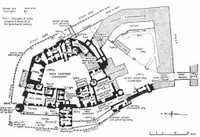
I. This floor plan is more useful in that it shows the north-west corner tower as the dark circle on the lower left, and to its righ, the dark rectangle of the WWII guardhouse reaching furthest out from the castle's west side. North is to the left on this map.
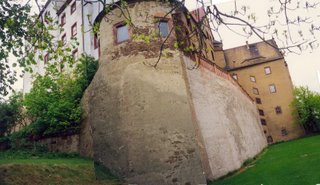
68. The north-west corner tower is seen here looking roughly south at the WWII guardhouse on the right.
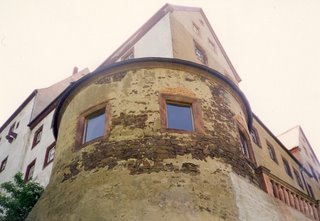
69. A close up of the top of the north-west corner WWII guardhouse with part of the north face facade on the left and a little of the west face facade on the right. We are looking about south-east here.
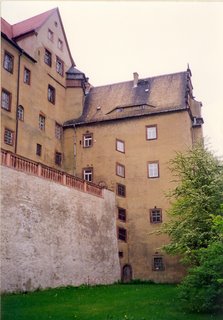
70. The north face of the WWII guardhouse is on the right. The upper terrace with railing is above the white wall. We are looking roughly south-east here. The grass lawn in the foreground was a garden previously. Note the abort shaft on the far right of the WWII guardhouse.
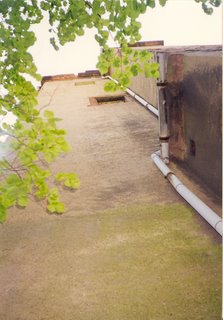
71. Looking east and straight up at the WWII guardhouse west facade. That is the abort shaft on the right.
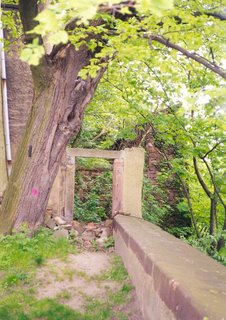
72. Looking south through the gateway that sits right at the north-west corner of the WWII guardhouse. Just past the thick tree truck on the left is where I looked straight up and took photo 71, with the white pipe visible in both photos.
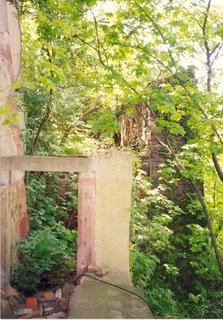
73. Still looking south at that gateway from up closer reveals the stout retaining wall that starts just beyond. This was a far as I dared walk to the south. Beyond here there was no safe path for me to follow. It was slippery after the recent rain, and the drop off to the right was quite steep down to the houses along the street below.
[This article is still "Under Construction".]
Sunday, April 09, 2006
18. Colditz Castle: Chronology/History
BC: Prehistoric Times:
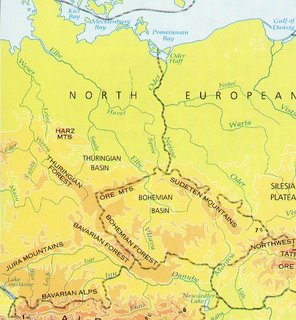
Hunters and gatherers were attracted to the mild and fertile Elbe river valley. Colditz will much later be founded roughly where the last "n" in Thuringian Basin is located. Image credit: Paul Robert Magocsi, Historical Atlas of East Central Europe, p. 3. ^
Prehistoric Saxony was the site of some of the largest of the ancient Central European monumental temples, dating from the 5th millennium BC. Text credit: wikipedia.
Notable archeological sites have been discovered in Dresden, and the village of Aythra near Leipzig. Text credit: wikipedia.
Before 100 BC - until 50 BC: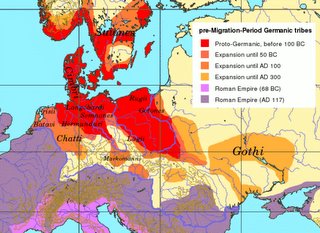
Areas inhabited by pre-migration period Germanic tribes from before between 100 BC and 50 BC (show in bright red and in bright orange) included the future site of Colditz.
BC: 49 - 1:
17 BC: Augustus understood that the Rhine frontier was still unstable and sent his adoptive sons Drusus and Tiberius to the north, where they had to pacify the tribes that were living between the Alps, Rhine and Elbe.
9 BC: This campaign was repeated in 9. One tribe, the Marcomanni, was so impressed, that its king Marbod decided to migrate with his people to Bohemia, far away from the Roman arms. In the summer, Drusus reached the river Elbe.
AD: 001 - 100 (The 1st century):
004: Although the Roman possessions on the east bank of the Rhine were not clearly defined, the region was tranquil, and remained so for the next decade and a half. At the beginning of our era, a general named Lucius Domitius Ahenobarbus even crossed the Elbe, and in 4 CE, Augustus decided that Germania had to become a normal province. Again, Tiberius was sent to the north. The army of Germania Inferior marched from the mouth of the Rhine through the inland to the sources of the Lippe, where a camp was built at Anreppen. Next year, the navy brought the legions to the mouth of the Elbe, and Tiberius marched along the river until he had reached the area of modern Dresden. (We have an eyewitness-account in the Roman History of Velleius Paterculus.)
005 - 006: The only part between the Elbe, Rhine and Danube that remained unconquered was the kingdom of Marbod, the leader of the Marcomanni. In the winter of 5/6, the army of Germania Superior marched to the east along the river Main and built a large base at Marktbreit. From here, two legions could attack Marbod; at the same time, Tiberius would march to the north from the Danube, where eight legions were gathered at Bratislava. It was to be the most grandiose operation that was ever conducted by a Roman army, but a rebellion in Pannonia obstructed its execution. Tiberius was occupied for three years until he had suppressed the insurrection.
009: Meanwhile, the army of Germania Inferior was commanded by Publius Quinctilius Varus, one of the most important senators of his age and a personal friend of Augustus. He had to make a normal province of the the country between the Lower Rhine and Lower Elbe, and had some success. However he was defeated by the Cheruscan leader Arminius in the battle in the Teutoburg Forest (September 9 CE). The Seventeenth, Eighteenth and Nineteenth legions were annihilated, and the Sixteenth Legion Gallica and I Germanica moved to the north to help V Alaudae secure the Rhine frontier.
The Elbe has long been an important delineator of European geography. The Romans knew the river as the Albis; however, they only attempted once to move the Eastern border of their empire forward from the Rhine to the Elbe, and this attempt failed in the Battle of the Teutoburg Forest in 9 AD, after which they never seriously tried again. Text credit: wikipedia.
009 -011: During the next three years, Tiberius was active on the east bank of the Rhine (he had only just suppressed the Pannonian revolt). Until then, about six legions had guarded the frontier; from now on, there were eight. The army of Germania Superior consisted of II Augusta, XIII Gemina, XIV Gemina, and XVI Gallica; I Germanica, V Alaudae, XX Valeria Victrix, and XXI Rapax were stationed in Germania Inferior. Diplomacy secured the alliance between the Romans and the Frisians and Chauci, but Arminius was able to create a federation of tribes. In 9, 10, and 11, Tiberius invaded Arminius' territory, but he did not want to reconquer the country between Rhine and Elbe: the Romans merely wanted to avenge themselves. It is likely that the construction of the Roman fort at Vechten is connected to this offensive.
012: In 12, Tiberius decided that it was enough, and accepted that the Rhine was the border of the Roman empire. He understood the Germans: left to their own, the federation of Arminius would soon disintegrate.
014 - 016: Two years later, Tiberius succeeded Augustus and became emperor. General Germanicus (a son of Drusus) now commanded the army of Germania Inferior. In 14, 15, and 16, he invaded the country between the Rhine and Elbe again, and was able to defeat Arminius in battle. The fort at Velsen was built as a naval base to support the attack. However, the renewed Roman attacks only served to strengthen Arminius' position, and Tiberius recalled his nephew. A few years later, the Germanic leader was assassinated.
028: From this moment on, Germania Inferior was only a small province: a small stretch of land to the southwest of the Lower Rhine, with the country of the Frisians and Chauci as an appendix. In 28, these tribes revolted, and although the Fifth legion Alaudae was able to overcome the rebels (tesxt), Tiberius gave up all territories on the other side of the Rhine. Germania Inferior was to remain an incomplete province.
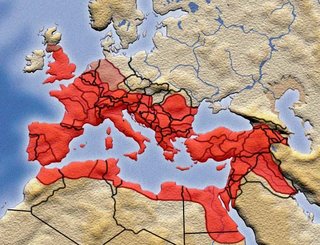
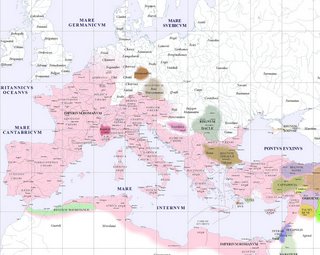
The Hermondvri [Hermunduri] people (show in brown)) occupied the region where Colditz would much later be founded. They were outside of the Roman Empire, shown in pink in this orientation map. Image credit: website. ^
"The Hermunduri (alternate spellings: Hermunduri, Hermunduli, Hermonduri, Hermonduli) were an ancient tribe of Germanic peoples who occupied the area around what is now Thuringia, Saxony, and Northern Bavaria, from roughly around 1 AD to 400 AD." Text Credit: wikipedia.
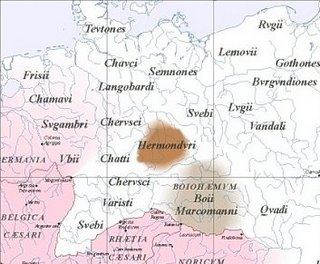
Just barely visible above the "o" in Hermondvri are the two hairlines that show the confluence of the Zwickauer Mulde and the Freiberger Mulda rivers. A few miles south of that confluence and on the left bank is where Colditz would much later be founded. Image credit: website. ^
The oldest seats of the Hermondvri people were located between the Thuringian Forest, the Ore Mountains, the Harz river, and the Black Elster river. Their area of settlement was north of a line from Eisenach west to Dresden. Text credit: website.
9: The Romans knew the river [Elbe] as the Albis; however, they only attempted once to move the Eastern border of their empire forward from the Rhine to the Elbe, and this attempt failed in the Battle of the Teutoburg Forest in 9 AD, after which they never seriously tried again. Text credit: wikpedia.
101 to 200 (The 2nd century):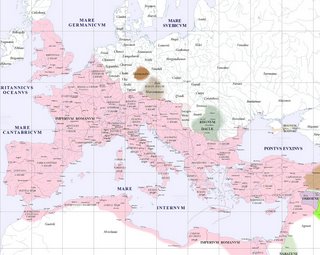 Another orientation map, since the Roman Empire had grown, but it still didn't and never would, include the Hermondvri lands. Image credit: website. ^
Another orientation map, since the Roman Empire had grown, but it still didn't and never would, include the Hermondvri lands. Image credit: website. ^
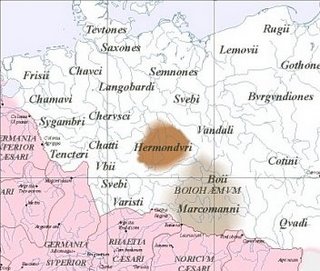
The Hermondvri were still in the same location for another century, but the Vandali to their east had moved closer to them. Image credit: website. ^
201 - 300 (The 3rd century): 
Orientation map showed Germanic frontier borders the same as they were in the previous century. Image credit: website. ^

This century saw the Hermondvri joined with the Hermvndvringi, but with a question mark, and the Vandali shifted back further east. Image credit: website. ^
301 - 400 (The 4th Century): 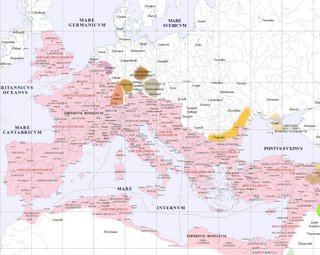
Orientation map showed Germanic incursions along the northern frontier, especially by the Alamanni. Image credit: website. ^
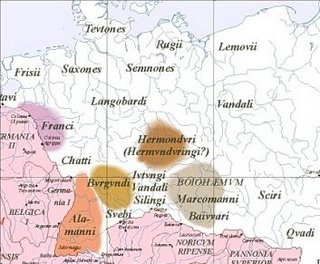
And through all these nearby changes and movements of Germanic tribes all around them, the Hermondvri/Hermvndvringi combination still sat right on top of Colditz's future location. Image credit:website. ^
395: The Western Roman Empire in 395. ^
401 - 500 (The 5th Century):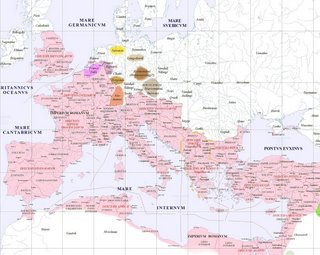
Orientation map showed the major changes of the 5th century with Rome's "Fall". Image credit: website. ^
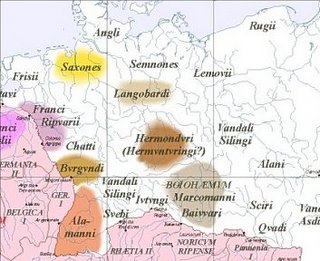
Still, through it all so far, the Hermondvri/Hermvndvringi held on in the Colditz area. Image credit: website. ^
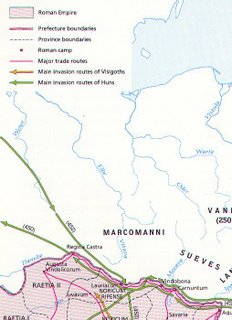
450 - 452: Major invasion routes of the Huns (450-452) shown in green. Image credit: Paul Robert Magocsi, Historical Atlas of East Central Europe, p. 6. ^
450 - 453: Under Attila the Huns ravaged large parts of east central and western Europe. Text credit: Paul Robert Magocsi, Historical Atlas of East Central Europe, p. 7.
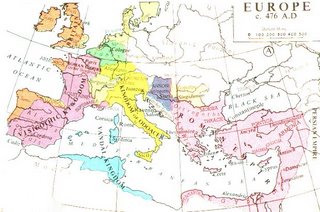
476: The 'end' of the Roman Empire. Image credit: website. ^
501 - 600 (The 6th Century):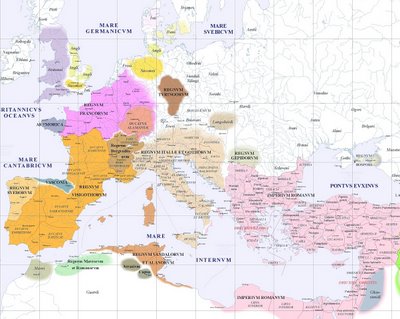
The 'Barbarian' overview. Image credit: website. ^

The Regnvm Tvringorvm [Thuringians] finally replaced the Hermondvri/Hermvndvringi in the Colditz area after about 450? years. Image credit: website. ^

511 - 561: Frankish lands. Image credit: website. ^
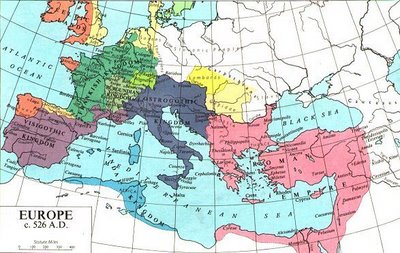 526: The Frankish Kingdom, with the Thuringians just beyond Frankish reach and control to the east. Image credit: website ^
526: The Frankish Kingdom, with the Thuringians just beyond Frankish reach and control to the east. Image credit: website ^
601 - 700 (The 7th Century):

Slavic expansion moved across the Oder river to the west in the 7th and/or 8th century. Paul Robert Magocsi, Historical Atlas of East Central Europe, p. 6. ^
701 - 800 (The 8th century):
Tuesday, April 04, 2006
17. Colditz Castle: Tour 1, Exterior, South Side & East Side
We'll circle around the exterior of Colditz castle in a counterclockwise direction from the entry house to the north-east tower in this Part One of our exterior tour.
 A. This aerial photo looks to the north-east. The entry house, where we'll start, is the tiny building with the long, narrow, and straight moat bridge angling slightly uphill at about 30 degrees behind and to the left of it.
A. This aerial photo looks to the north-east. The entry house, where we'll start, is the tiny building with the long, narrow, and straight moat bridge angling slightly uphill at about 30 degrees behind and to the left of it.
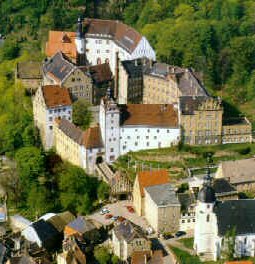
B. This aerial photo looks almost due north. The entry house is just above and to the left of the center-foreground building with the red roof.
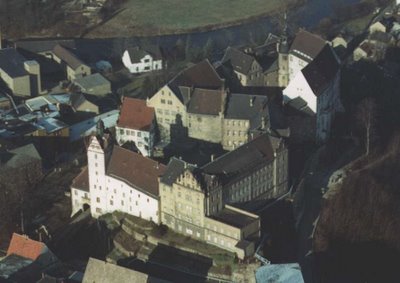
C. This aerial photo looks to the north-west-north. The entry house is just above the building in the lower left corner with the red roof.

D. This floor plan is tilted on its side so that south is at the bottom. The entry house is the small open on its right side building at the very bottom.

1. Looking north-east up at the entry house on the south end of the castle from a cobble stone street below. That is the entry house with the red sign attached to it, and with the 'vertical' Renaissance decorations on its upper facade.

2. The entry house from its small parking lot just to the south of it. Repairs were under way here and elsewhere on the castle property. The Russians and East Germans allowed the place to deteriorate from 1945 to 1989, as it was felt to be a monument to WWII Allied POW escapes that the Communists certainly didn't want to publicize. I don't recall what the red sign said.

3. Three signs are displayed on the facade of the entry house.
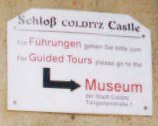
4. This sign guides would-be visitors to the castle to go to the Colditz museum first to pay, get their ticket, and join a guided tour. The English language part reads: "For Guided Tours please go to the Museum".

5. In German and in English this sign tells you a little about Colditz castle as a POW camp (Oflag IV C) from 1939-1945.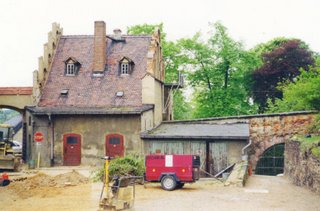
6. Moving to the right now and looking west to start our counterclockwise walk around the outside of the castle, we see the entry house from the east side. To the right of the entry house is the start of the steep moat bridge. Smaller vehicles can enter the castle by this route?

7. This similar view to the one in the photo just above is looking north-west, with the red generator gone and workers putting down cobble stones, shows more of the moat bridge with part of a tour group on its upper end.

8. A closer view (looking north-west) of the upper end of the moat bridge with the bottom of the now dry moat below. I believe that the moat has been waterless for hundreds and hundreds of years now. If there had been a long-ago drawbridge, it would have been against the front of the castle right at the archway on the right.
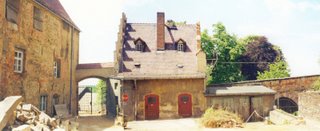

9. and 10. Two quite similar photos looking west show the entry house and some of the building to the left. The lower photo is from further back, and introduces a little of the tiered and vegetation-covered terrace to the right at the moat bridge end. There is that red generator again.
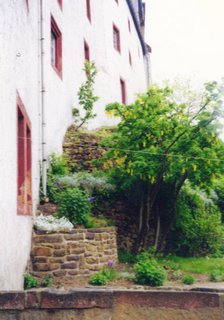
11. Looking east along the south outer facade of the castle. The vegetation-covered tiers of the terrace can be seen in part.

12. Those vegetation-covered tiers of the terrace are clearly visible here, again looking roughly east. The flat-roofed building with the five 'spikes' on top is what I call the (5-windows across) 'cube' building. The building in back on the horizon was the WWII 'married' quarters, so let's just call it that. A lot more will be said about both those buildings, starting with photo 14.

13. Now let's step back and look north up at the south facade of the castle itself. There's that familiar red generator again. And seen behind it the three vegetation-covered tiers of the terrace, and from left to right the main gate house, the tall tower, the rest of the white-painted facade, and the start of the tan building units, the first one 2-windows-across and the second one 4-windows-across.

14. Looking roughly north-east here shows the two tan units (the 2-windows-across and the 4-windows-across) and the 5-windows-across 'cube' building with its five 'spikes' on top to the far right.

15. Looking east-north-east down again at the east end of the south face where the terrace is more stone than vegetation-covered tiers, we can still barely see the entry house in the distance. We'll talk more about the round stone tower and the two sets of steps on the far right.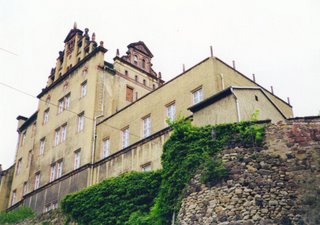
16. Here again (looking roughly north-west) are the tan building units (the 2-windows-across and the 4-windows-across) seen in photo 14, with the 5-windows-across 'cube' building with its five 'spikes' on top to their right, plus a storage shed on top of the round stone tower. This round stone tower is in the very south-east corner of the castle complex. Note the pair of upper facade 'vertical' Renaissance decorations that are so similar to those on the entry house.
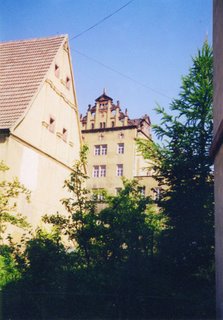

17. and 18. We are looking roughly north-west from a street further to the south for this similar pair of photos taken across lawns. The two photos show the 4-windows-across tan unit with the 'vertical' Renaissance decorations at the facade top.

19. The 5-windows-across 'cube' building with its five 'spikes' on top.
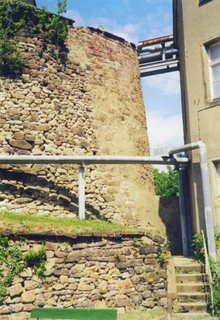
20. We have jumped back up close again, and are looking roughly north-east. Here is that round stone tower seen in photos 14 and 15. The stone steps on the right actually just fit between the round stone tower and the WWII 'married' quarters. There should be a side door into the quarters down that walkway, but I don't know for sure. I didn't walk down there to check. But past it is a awll with at least a 15 foot drop to the level of the wide service road below. Much more on that service road shortly here, when we go around behind the castle to continue our tour.
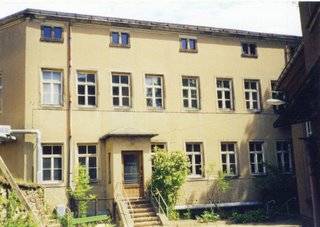
21. Here is the WWII 'married' quarters that almost butts right up against the south-east corner of Colditz castle. These current apartments? are two stories tall on this side, plus their attic and basement windows. We are looking very roughly north-east.
Since we won't be leaping off of that at least 15 foot drop off to get around behind the castle, we'll have to walk around by an indirect route. So we'll turn around, and walk west till we again stand in front of the entry house, and then walk south to the street with the Colditz Museum on it, and walk east up that street to the museum. Let's look at the exterior of the museum as we pass by.
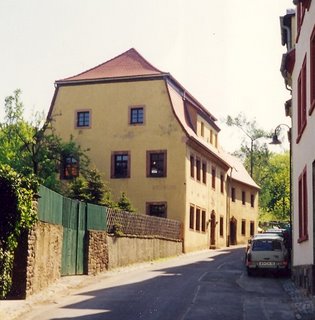

22. and 23. The first of the above photos sees us approaching the Colditz Museum walking uphill roughly to the east. In the second photo we are looking downhill, and back roughly to the north-west.
Afterwards, we can continue east and slightly uphill to a road intersection, and then walk a little further north to the next intersection. Follow the road north for a hundred feet or so, and then turn sharp left (north-west), and follow the wide service road as it leads to the back of the castle.
Colditz castle east side:

E. For orientation purposes for the east side of the castle, this aerial photo is the most helpful. Most everything discussed above is here, but trying to describe where it is would be next to impossible.
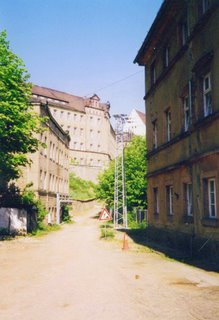
24. Here we are walking north-west up the wide service road toward the back of the castle. We move past the WWII and perhaps earlier stables that are not visible on the left, much of the Terrace House on the right, and the WWII 'married' quarters ahead on the far left. The castle's WWII Kommandantur is on the horizon, with windows #11-#17 of the 17-windows-across south 'face' visible.
The road is starting to curve to the right way up ahead after running straight from the corner behind us. Note that the WWII 'married' quarters are three stories high on this side, plus those attic windows again. This wide service road is much lower than the dead-end alley in front of the vegetation-covered tiered terrace.
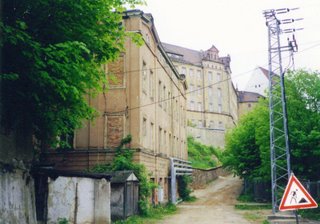
25. Here we are walking north-west and moving closer to the castle with the Terrace House now beside us and out of sight on the right. Up ahead the wide service road starts to curve to the right, and head uphill.
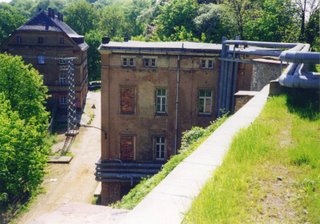
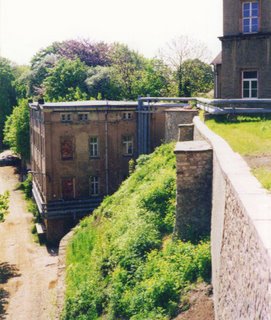
26. and 27. Let's pause and look back down (to the south-east, roughly) the straight part and the starting to curve part of the wide service road from a vantage point up on the grass terrace that we haven't reached or talked about yet. That's the Terrace House on the left and the WWII 'married' quarters on the right in the upper photo, and the 'married' quarters and a sliver of the 5-windows-across 'cube' building in the lower photo.
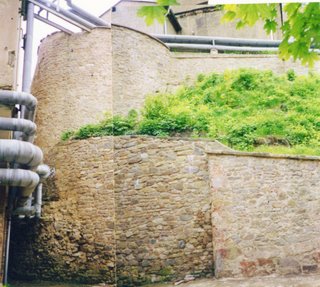

28. and 29. Two photos of what is in the gap between the west end of the WWII 'married' quarters and the 45 degree slope of the castle ramparts that is hidden in photos 23 and 24. Note the at least 15? foot drop off in photo 26 just above. In both the photos you can se the base of that south-east corner tower with its stonework and supporting rampart. We are looking roughly south-east.
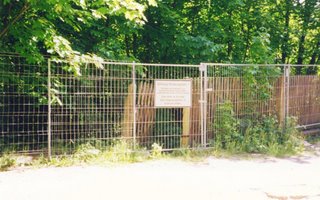


30., 31., and 32. Now let's turn around about 180 degrees and face the Park, and look to the north-east. We'll visit the Park later. The path down to the Park, where the POWs got their fresh air, exercised, and escaped, is now blocked off by this gate, and entry is forbidden. The sign tells us as much.


33. and 34. On up the curving wide service road past the round south-east tower rampart base to where you can see the archway that leads into the outer WWII German courtyard. The quarter-round and tan WWII canteen building and the white WWII Dutch quarters building are just staring to come into view. We are looking north-west-north here roughly.
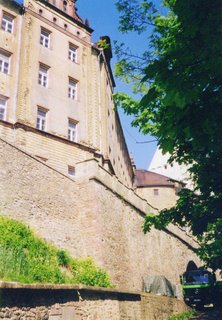
35. Looking up from the wide service road below at part of the two 'faces' of the WWII Kommandantur on the left. There is the 17-windows-across 'face' at the south end, and the 12-windows-across 'face' at the north end. Here we can only clearly see windows #15-#17 of the 17-windows-across south 'face'. That's the back end of a parked blue truck sticking out of the archway. On the right is a glimpse of the WWII Canteen building unit. We are looking roughly north-west-north.

36. Turning around and looking south-east back downhill from just before the archway entry is reached. The WWII 'married' quarters in in the background down where the road has finished curving to the left.
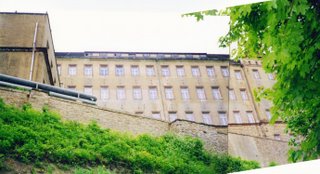
37. Again, looking up from the wide service road below at 15 of the 17-windows-across south 'face' of the WWII Kommandantur building, with a part of the 'cube' building on the far left. We are looking due west.

38. Looking up yet again from the wide service road at the southern end of the WWII Kommandantur 'cube' with its five 'spikes' on top. We are looking south.


39. and 40. These are both the same photo that has been tilted up, then down. Both of course look up from the wide service road below. We are looking roughly north-west. All 12 windows of the 12-windows-across north 'face' show clearly, despite the distortion (ragged roof-line) at the top of these two photos.

41. Here the quarter-round tan WWII Canteen building is seen from below on the wide service road.
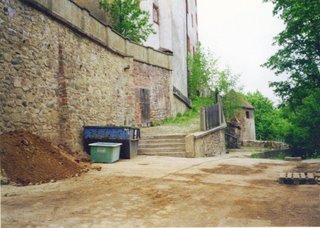
42. That is the remains of the north-east corner tower in the background, but more on it later. Right now we will continue walking north, climb those five steps, walk up the short path, and turn 180 degrees and walk south up the path beside that black sloping rail onto the large two roughly triangular grass terraces adjacent to the WWII Kommandantur. We are looking north here.
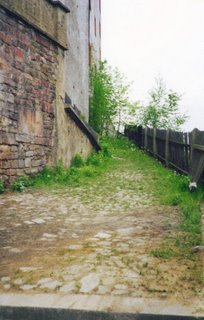
43. This closeup of the path begins with the top step in the foreground. Beyond the black sloping rail we will be taking, the north bound path just ends abruptly up near the north-east tower. It is currently a 'path to nowhere'. We are looking north.

44. By ascending that 'path to nowhere' a little ways uphill allows us to look back south to where we will be heading up onto the grass terrace adjacent the WWII Kommandantur. So it is up the worn slope, up the eight steps, through the open gate, and out onto the grass terrace. We are looking south. The 'cube' building with its 'spikes' just barely shows. Visible also are windows #1-#5 of the 12-windows-across north 'face'.
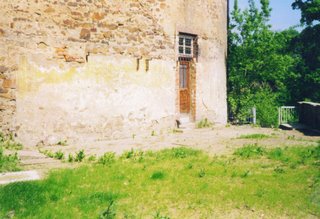
45. Looking roughly north-east back at the gate from the grass terrace we see roughly where Pat Reid's Canteen Tunnel emerged. WWII escape photos are yet to be added.

46. From further out (south) on the grass terrace we look north-east-north and see the WWII Kommandantur on the far left, the quarter-round WWII Canteen building in the middle, the open gate at lawn level, and the WWII Dutch quarters (with its once tunnel-containing) buttress on the right. Visible on the left are windows #9-#12 of the 12-windows-across north 'face'.
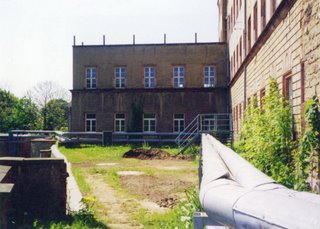
47. We are looking south straight at the north side of the 5-windows-across 'cube' building. The bend in the pipes in the right foreground shows where the WWII Kommandantur changes angles to the 12-windows-across north 'face', which is not visible in this photo.

48. Looking north-west at 14 of the windows of the 17-windows-across south 'face' of the WWII Kommandantur. This 'face' of 17 windows includes the two windows in the parallel center section with the 'vertical' Renaissance decorations on top. The sharp bend in the left foreground is where this 17-windows-across 'face' joins the 'cube' building. That the left third of this 'face' appears to 'curve' is just an illusion.
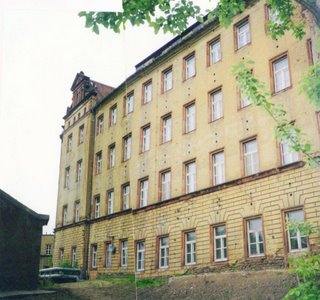
49. This photo shows windows #1-#11 of the 12-windows-across north face of the WWII Kommandantur. This north 'face' also starts with that same 'vertical' Renaissance decoration at the top of the facade. We are looking roughly south with one 'spike' on the 'cube' building just visible between the shed and the WWII Kommandantur.


50. and 51. These matched end to end photos (with just a little overlap) show the 12-windows-across north 'face' of the WWII Kommandantur. We are looking west, more or less.


52. and 53. Let's look back again, this time from a hill (to the north and east) about as high as the premontory Colditz castle was built on, and take a long look at each half of the east facade of the castle. In both photos we are looking roughly west to south-west. In the top photo all 17-windows-across of the south 'face' are visible, plus the first three of the north 'face'. In the bottom photo we see all 12 windows of the 12-windows-across north 'face', plus 14 of the 17-windows-across 'south' face to their left.
 54. We again walk down these 8-steps, down the path, turn right almost 180 degrees and walk down that path, then back down the 5-steps, and turn 180 again to continue north up the service road.
54. We again walk down these 8-steps, down the path, turn right almost 180 degrees and walk down that path, then back down the 5-steps, and turn 180 again to continue north up the service road.

55. As we continue north along the service road we'll see the entry to the winding path through the woods down to the north end of the Park, but we won't take it now or go down to the Park at this time. The WWII POWs did not use this path to the Park.

56. Facing back to the left and up from service road we see the facade of the WWII Dutch quarters, with the buttress down through which they started a tunnel. The north-east corner tower is in the right foreground. We are looking north-west here.
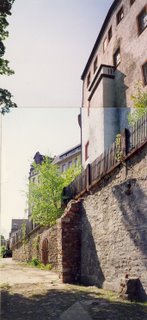
57. Looking back due south, and yes, that is the 'cube' building on the far left above the ramparts. That is part of the Dutch quarters with the buttress on the right.

58. Getting close to the NE corner with its damaged tower.
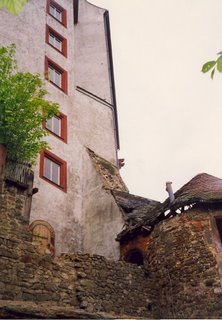
59. More of the damaged north-east corner tower.

60. The north-east corner tower looks to be in better shape here.
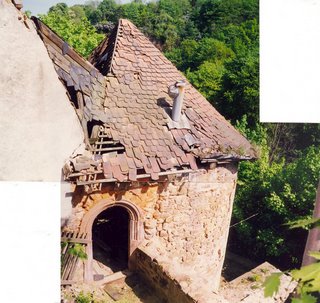
61. Plenty of roof detail of the north-east corner tower.
Go to the article titled "Colditz Castle: Tour 2, Exterior, North Side & West Side" to see the rest of the still unfinished tour around the exterior of Colditz castle.
[This topic is still "Under Construction".]